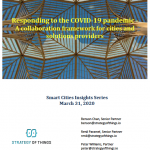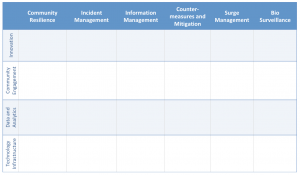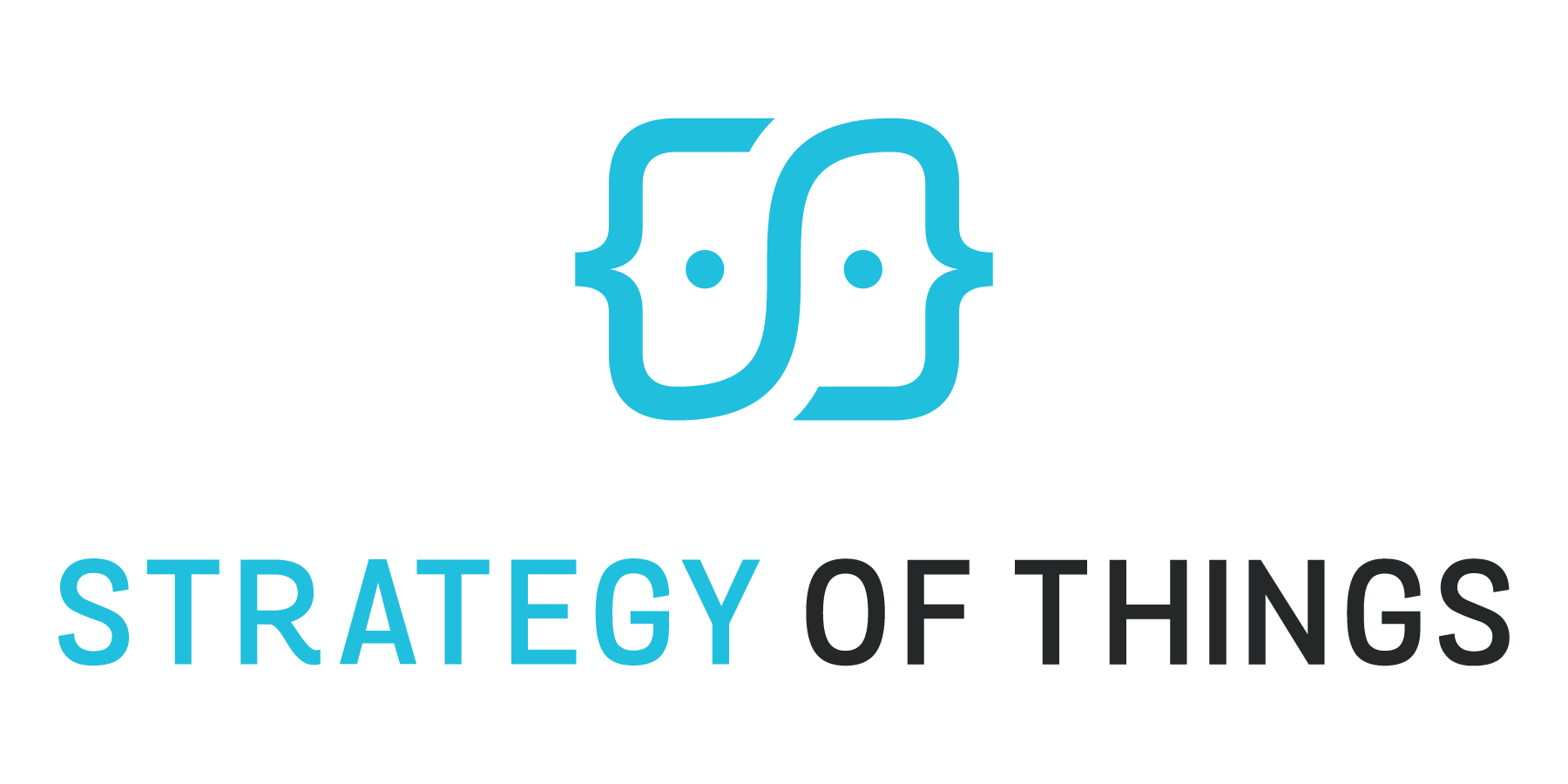Community COVID-19 Response Innovation Project Portfolio
Silicon Valley City Reopening Readiness Assessment
Situation: In response to the COVID-19 pandemic, a midsize city in Silicon Valley closed their facilities to in-person working and public services. With the COVID-19 vaccine beginning to be administered to members of the community, the city is planning to reopen their facilities to staff and the public on July 1.
The city has implemented some measures and policies, but wants independent assessment and validation of their efforts. They want to understand if they have done enough, and to identify any gaps to be addressed, in order to ensure a safe reopening and return to in-person activities. The city has 18 facilities to be assessed, including the City Hall building, the police station, library, community center, and others.
 Approach: We benchmark the city's readiness against a model of a COVID-19 Safe Space to answer three questions:
Approach: We benchmark the city's readiness against a model of a COVID-19 Safe Space to answer three questions:
- How ready are city facilities to reopen?
- How ready are staff and visitors to return, and is the city ready for them to return?
- Is the city ready to maintain and support staff and visitor safety needs after reopening?
We applied our Safe Space framework, a model that we co-developed with a small team of scientists, engineers and respected domain experts from Great Places and Spaces, Peter Williams Consulting, and Change Impetus. This framework brings together the science of COVID-19 transmission; building and ventilation science; codes, public health guidelines and best practices; policies and practices; technology and innovative tools; space design and layout; people and organization; governance and operations; building infrastructure and metrics. We combine physical facility inspections, along with the assessment model, to score the effectiveness of the city’s responses and measures, identify gaps and create actionable recommendations.
Result/Outcome: The project has been completed, and the city is incorporating the assessment results and recommendations into their reopening plan. A series of recommendations, across four broad categories, was provided to the city for action. These categories include:
- Address compliance gaps with government guidelines
- Implement a “transition success” program to guide people back to in-person activities
- Increase operational and infrastructure readiness to support reopening and beyond in a high occupancy environment
- Increase response agility and execution speed to limit COVID-19 spread as people return and exposure risks increase
Additional Information:
- Case study - Silicon Valley City Reopening Readiness Assessment
- Creating COVID-19 Safe Spaces for Reopening and Return to Work (Part One)
- Creating COVID-19 Safe Spaces for Reopening and Return to Work (Part Two)
- COVID-19 Safe Spaces Presentation
- Top 5 solutions impacting cities Post-COVID
Community Success and Engagement Program to Support Major Public WiFi Site Expansion
Situation: The COVID-19 pandemic has forced all public K-12 schools within the County of San Mateo to close in-person instruction. Almost immediately, classroom instruction shifted to online learning. However, across the county, there were a significant number of students who had no Internet connectivity at home and were not able to participate in learning. The county, in collaboration with the eleven most affected school districts, embarked on a major public WiFi site expansion. This effort implemented over 250 access points across 10 cities in less than six months.
Community, school district, student, political and industry partners were vital to the success of the project. However, in many of these communities, traditional channels and strategies to drive engagement, awareness and adoption, do not work. A variety of languages are spoken. Many in the community cannot be reached through traditional channels. Technology and digital skills in the community ranged from competent to poor. Many partners are involved and coordination among the parties was challenging.
Approach: We implemented a holistic and community-led engagement approach focused on partnerships, trusted messengers, and partner empowerment. We created a self-support ecosystem within the community to help students and residents adopt and use WiFi, by recruiting and empowering and training community champions. We employed a strategy of continuous and weekly engagement to increase community support through our partners’ community networks, communications and engagement vehicles, and established methods.
Results/Outcomes: Over 250 community wireless access points were launched across 10 cities and over 20 unique sites in December 2020. Over 50 champions across eleven school districts and ten cities were recruited, trained and onboarded to ensure a seamless adoption and technical support of WiFi for schooling. Over 2000 public school students were positively affected and now have access to the Internet for schooling. A variety of communications, engagement and training tools were developed and delivered, including press releases, awareness flyers, users and troubleshooting guides, Frequently Asked Questions, and community training sessions and materials.
Additional Information:
- San Mateo County expansion free WiFi access to East Palo Alto
- 13 outdoor public WiFi spots launch in San Mateo County
- County to expand wireless connectivity for Redwood City students
Responding to COVID-19 – A collaboration framework for cities and solutions providers
 Situation: The coronavirus COVID-19 pandemic has disrupted cities and communities worldwide. Although cities have emergency and disaster response plans, the scale of the outbreak has strained their resources and capabilities. “Smart City” technologies, with their innovative digital approaches and capabilities, offer the potential to facilitate city responses to COVID-19. As a result, municipalities have turned to technology companies for help.
Situation: The coronavirus COVID-19 pandemic has disrupted cities and communities worldwide. Although cities have emergency and disaster response plans, the scale of the outbreak has strained their resources and capabilities. “Smart City” technologies, with their innovative digital approaches and capabilities, offer the potential to facilitate city responses to COVID-19. As a result, municipalities have turned to technology companies for help.
Many established and start-up technology companies have responded with ideas and proposals. However, the results have been mixed and uneven. Some problem areas get a lot of ideas while others get none. Still other ideas are unfeasible. Many respondents lack understanding of how cities respond to health emergencies.
Approach: The National Preparedness System was established in 2011 in response to Presidential Policy Directive 8 on national preparedness and resilience to Natural and Man-Made Disasters and Hazards. In response, the United States Centers for Disease Control and Prevention (CDC) developed a set of standard capabilities that municipalities and public health systems should incorporate to prepare for, respond to, and recover from public health emergencies. These capabilities are intended to be the "standard operating procedure" for responding to health emergencies.
 We used this as the foundation, and overlaid the Strategy of Things smart city ecosystem framework over it. This created a framework in which the key capabilities and activities in responding to health emergencies, are augmented by four key layers of the smart city - the innovation ecosystem, community engagement, data and analytics and technology infrastructure.
We used this as the foundation, and overlaid the Strategy of Things smart city ecosystem framework over it. This created a framework in which the key capabilities and activities in responding to health emergencies, are augmented by four key layers of the smart city - the innovation ecosystem, community engagement, data and analytics and technology infrastructure.
Result/Outcome: The white paper was completed and published in March 2020. The framework now provides cities and the technology and innovation community with a structured way to identify areas of need and collaboration. This more effectively provides the innovation community with a holistic view of the different areas of need, and facilitates more engaged and proactive participation.
Additional Information:
Want to Learn More?
Have questions or want to discuss our learnings and progress from our smart city projects?
Please feel free to reach out to us. We're always happy to share knowledge and exchange ideas.

